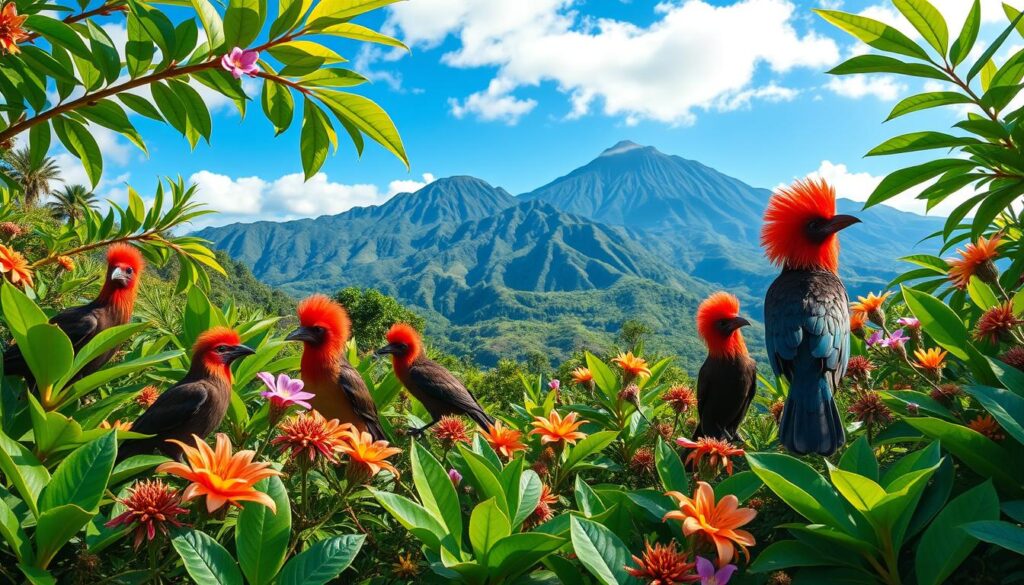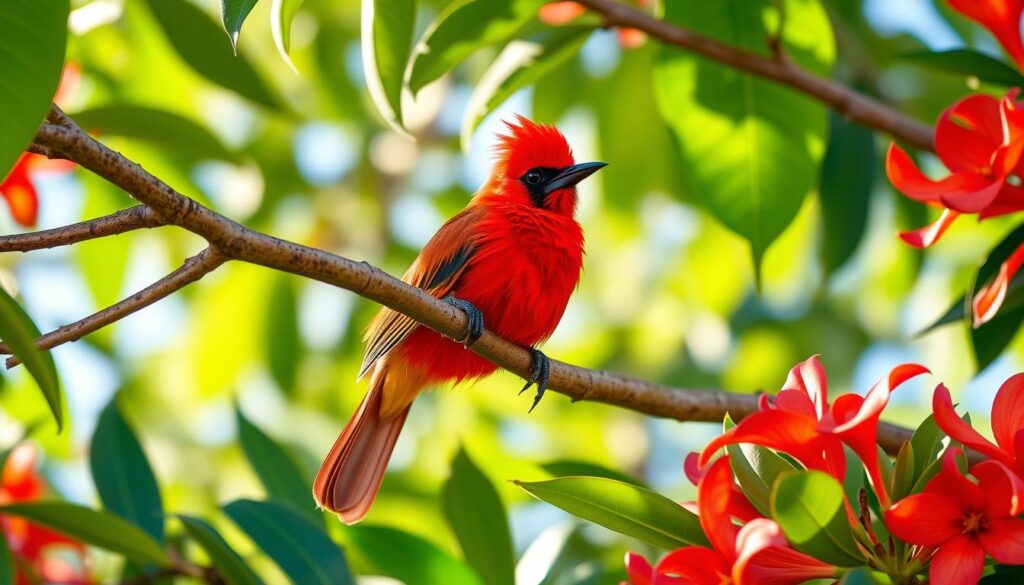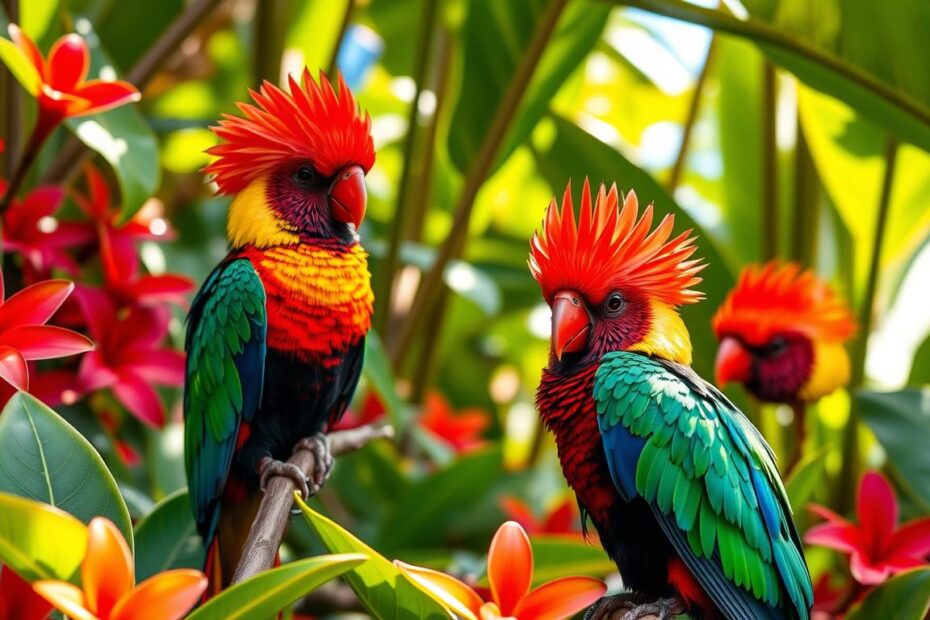As I look out at the lush Hawaiian landscapes, I see vibrant colors in the trees and air. These are the ‘i’iwi, the iconic Hawaiian honeycreepers. Their bright red feathers show the tropical beauty of this isolated place. These birds, with their special beaks and songs, are key to Hawaii’s unique wildlife.
The ‘i’iwi and other Hawaiian birds show the islands’ rich history and evolution. But, as I learn about the dangers they face, I worry about their future. Threats include habitat loss, invasive species, and diseases.
Key Takeaways
- The Hawaiian archipelago is home to a diverse array of endemic bird species, including the iconic ‘i’iwi honeycreeper.
- These birds, with their bright red plumage and captivating songs, represent the tropical beauty and natural wonders of the Hawaiian islands.
- The ‘i’iwi and other Hawaiian birds have evolved through a remarkable process of adaptive radiation, resulting in a unique and fragile avifauna.
- However, these species face numerous threats, including habitat destruction, invasive species, and emerging diseases, putting their future at risk.
- Conservation efforts are underway to protect the ‘i’iwi and other Hawaiian bird species, but the challenges they face are significant and ongoing.
The ‘I’iwi: Iconic Hawaiian Honeycreeper
The ‘i’iwi (Vestaria coccinea) is a bird found only in Hawaii. It’s known for its bright red color and beautiful song. This bird is a symbol of Hawaii’s rich bird life.
Its red body and black wings make it stand out. The female has an orange head and red collar. Seeing a ‘i’iwi is unforgettable.
Bright Plumage and Mating Rituals
The male ‘i’iwi’s red color comes from eating nectar from Hawaiian plants. This color helps in finding a mate from January to June. During this time, males show off their bright feathers to attract females.
The female lays 2-3 eggs in a nest. This continues the cycle of this amazing Hawaiian bird.
Coevolution with Hawaiian Lobelioids
The ‘i’iwi’s long beak lets it reach nectar in Hawaiian plants. This shows how the bird and plants have evolved together. The ‘i’iwi helps the plants by pollinating them, and the plants give the bird food.
“The ‘i’iwi is a true ambassador of Hawaii’s unique and captivating avifauna, showcasing the incredible diversity and interdependence of the islands’ endemic species.”
Threats to the ‘I’iwi and Hawaiian Flora
The ‘I’iwi and other native Hawaiian birds face many dangers. The biggest threats are invasive species and the loss of their homes.
Invasive Species and Habitat Loss
The ‘I’iwi’s food, the endemic Hawaiian lobelioid flowers, are disappearing. This is because of invasive plants. These plants take over the food sources of the ‘I’iwi and other birds.
Feral animals like goats and rats also harm the ‘I’iwi’s home. They destroy the plants the ‘I’iwi needs to survive.
Feral Animals and Avian Malaria
Non-native mosquitoes have brought avian malaria to Hawaii. This disease is deadly to birds. It can kill a bird with just one bite.
The ‘I’iwi is especially at risk. Its numbers are dropping fast because of avian malaria.
| Threat | Impact |
|---|---|
| Invasive Species | Displacement of native food sources, disruption of ecological balance |
| Feral Animals | Destruction of critical habitat, feeding on endemic plants |
| Avian Malaria | Extremely high mortality rates, devastating impact on forest bird populations |
These dangers, along with habitat loss and diseases, threaten the ‘I’iwi. Saving these birds is urgent. We must act now to protect them.
Conservation Efforts for the ‘I’iwi
The ‘i’iwi, a symbol of Hawaii, faces many threats. To save it, a wide range of conservation efforts are underway. These include restoring habitats and managing invasive animals. This helps the ‘i’iwi find food and shelter.
Protecting the ‘i’iwi from avian malaria is also a key focus. Scientists are using genetically modified mosquitoes to control local mosquito populations. This method has shown success in places like China and Mexico. The National Park Service is now exploring it for Haleakala National Park to protect the ‘i’iwi and other endangered birds.
| Conservation Efforts | Impact |
|---|---|
| Fencing cattle grazing grounds | Reclaiming ecosystems for native plants and birds |
| Managing feral animal populations | Reducing threats to native habitats |
| Increasing native plant abundance | Providing food and shelter for the ‘i’iwi |
| Releasing genetically modified mosquitoes | Suppressing mosquito populations to protect birds |
The future of the ‘i’iwi and Hawaii’s nature depends on us. Local communities, nature lovers, and government agencies must work together. By tackling the challenges facing the ‘i’iwi, we can keep its bright red color in the Hawaiian skies for years to come.
“The urgency to intervene to save biodiversity is highlighted by the need for continued human effort in conservation projects.”
Hawaii’s Diverse Avifauna: Past and Present
Before humans arrived, Hawaii was home to over 113 bird species found nowhere else. The Hawaiian Honeycreepers, with 59 known species, show amazing adaptability. These birds are a key part of Hawaii’s bird history.
Endemic Species and Adaptive Radiation
The Apapane is a small bird with bright red feathers. The I’iwi is a bit larger, with males having stunning red plumage. These birds highlight the incredible diversity that evolved in Hawaii.
Extinction Threats and Conservation Status
Hawaii is sadly known for losing 71 bird species since humans arrived. This includes 48 species lost before Europeans came. Today, 31 of the remaining species are threatened or endangered.
Key threats include habitat loss, invasive species, and the decline of native plants. These plants are crucial for the birds’ survival.

Efforts to save Hawaii’s birds are underway. Groups like the Kauaʻi Forest Bird Recovery Project and the Hawaii Division of Forestry and Wildlife are working hard. Their goal is to protect these unique birds and their habitats for the future.
Hawaii Birds with Red Head: Field Guide
The Hawaiian islands are a true avian paradise, home to a diverse array of bird species, many adorned with vibrant red plumage. In this comprehensive field guide, we’ll explore some of the most captivating red-headed birds found in Hawaii, from the iconic ‘i’iwi to the state bird, the Nene.
Red-Crested Cardinal
The Red-Crested Cardinal, native to South America, is a common sight in Hawaiian parks and gardens. It has a distinctive bright red crest, black face, and gray body. This striking bird is easily recognizable. These non-native cardinals have adapted well to the Hawaiian environment and are often observed foraging for seeds and insects.
Japanese White-Eye
Another red-headed bird found in Hawaii is the Japanese White-Eye. Introduced to the islands in 1929 to control insect pests on sugar plantations, this small songbird now thrives in a variety of habitats, from urban areas to native forests. Their bright red eyes and yellow-green plumage make them a captivating addition to the Hawaiian avifauna.
‘I’iwi
The iconic ‘I’iwi, a stunning red honeycreeper, is found exclusively in Hawaii. Residing in the cool rainforests above 4,100 feet, this endemic bird is known for its striking crimson feathers, curved bill, and unique mating rituals. The ‘I’iwi is a true symbol of Hawaii’s unique and fragile ecosystem.
Nene
The Nene, Hawaii’s state bird, is a rare and endangered goose with a distinctive red head and black neck. Once on the brink of extinction, conservation efforts have helped to slowly increase the Nene population, making it an important symbol of the islands’ commitment to protecting their native species.
These are just a few of the remarkable red-headed birds found in the Hawaiian archipelago. From the vibrant cardinals to the iconic ‘I’iwi, these birds add to the natural beauty and ecological richness of the islands. As we continue to explore and appreciate Hawaii’s diverse avifauna, it’s crucial that we also work to protect these captivating species for generations to come.
The Coevolutionary Relationship: ‘I’iwi and ‘Ōhi’a Lehua
Hawaii’s native plants and animals have evolved together in a special way. Many species depend on each other to survive. The ‘i’iwi bird and the ‘ōhi’a lehua tree are a perfect example of this.
The ‘i’iwi, a colorful bird, needs food badly. It now eats nectar from the ‘ōhi’a lehua tree. This tree is very important in Hawaiian culture. People believe it cries when its flowers are picked.
This relationship shows how crucial it is to save Hawaii’s native plants and animals. By doing this, we help keep the balance in Hawaii’s tropical forests. We learn how important native plants and birds are for these unique ecosystems.
“When the lehua is pulled from the branch, tears will fall from the sky, for the tree and flower have been separated.”

The ‘i’iwi’s bright colors and the ‘ōhi’a lehua’s cultural value make their bond fascinating. Saving these plants and birds helps keep Hawaii’s forests beautiful and strong. This is for the future of our planet.
Experiencing the Beauty of Hawaii Birds
The Hawaiian islands are a birdwatcher’s dream. Kaua’i, known as the “Garden Isle,” is a top spot for bird lovers. It’s home to many native and introduced birds, thanks to its lush landscapes and untouched wilderness.
Kaua’i: The Garden Isle
Kaua’i’s varied habitats, from waterfalls to rainforests, are perfect for birdwatching. You can see native birds like the ‘I’iwi and ‘Apapane. Introduced birds, like the Brazilian cardinal, also call Kaua’i home.
Common Native and Introduced Species
- The ‘I’iwi, a striking scarlet honeycreeper, is one of Hawaii’s most iconic native hawaii birds.
- The ‘Apapane, the most abundant of the Hawaiian honeycreepers, showcases a diverse array of singing styles across the different islands.
- The Ae’o, or Hawaiian stilt, is an endangered species and a subspecies of the black-necked stilt.
- The Brazilian cardinal, an introduced species, has established a stable population on Kaua’i, adding to the island’s vibrant birdlife.
Visiting Kaua’i lets you appreciate Hawaii’s birding and natural heritage. The island’s beauty and bird songs make for an unforgettable experience for all.
“Exploring the vibrant bird life of Hawaii is a truly captivating experience for nature enthusiasts and birdwatchers.”
| Species | Population Status | Key Characteristics |
|---|---|---|
| ‘I’iwi | Endangered | Striking scarlet plumage, specialized bill for feeding on ‘Ōhi’a lehua flowers |
| ‘Apapane | Abundant | Most numerous of the Hawaiian honeycreepers, diverse singing styles |
| Ae’o | Endangered | Subspecies of the black-necked stilt, found in wetland habitats |
| Brazilian Cardinal | Stable | Introduced species, social behavior and courtship displays |
The Importance of Bird Conservation
Keeping Hawaii’s bird life alive is key to the islands’ natural beauty and culture. These birds are like living history books, showing us Hawaii’s past and future. By helping conservation, bird lovers and nature fans can protect endangered birds, fix habitats, and support eco-friendly tourism.
President Biden’s Bipartisan Infrastructure Law shows a big commitment to saving Hawaii’s birds. It gives over $14 million to fight avian malaria and $1.4 billion for ecosystem fixes. These steps are crucial for saving birds like the ‘i’iwi and many others. They also help keep Native Hawaiian traditions alive by using their knowledge of nature.
Protecting Hawaii’s birds, like the ‘i’iwi, is vital for the islands’ beauty and culture. As we work to save endangered species, fix habitats, and support green tourism, we all help. Together, we can keep bird conservation at the heart of Hawaii’s ecosystem.
